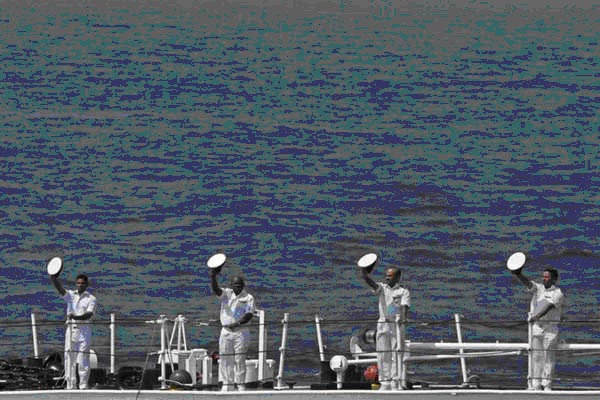India’s Growing Naval Strength In Indian Ocean
09 November 2018
In the first week of this month the Prime Minister broke the news to the nation that India’s first indigenously built nuclear submarine Arihant had successfully completed its first ‘deterrence patrol’. Though the PM did not make such a claim, a section of the media claimed that the submarine-launched ballistic missiles or SLBMs Arihant is equipped with have brought both Pakistan and China within their striking range.
From information available in public domain, Arihant is equipped with 12 K15 SLBMs, which have a range of 750 kms. The K15 missile can be used for retaliatory strikes against Pakistan but it cannot be used against China. For Arihant to hit China, it must have the K4 SLBM with a range of 3,500 kms and can carry a nuclear or conventional payload of 2,000 kg. India has reportedly test-fired the K4 twice but there is no official confirmation yet that it has been inducted by the Indian navy.
India has undertaken an ambitious expansion plan for the navy to counter the growing presence of the Chinese navy in the Indian Ocean. The plan seeks to raise the fleet strength of the Indian navy from the present 137 ships to 200 by 2027. India plans to build five more N-subs. Along with Arihant, these will increase Indian’s nuclear submarine fleet to six. Once these subs are commissioned, India can truly claim to have its nuclear triad put in place. Then there are the diesel-electric conventional submarines.
Last year it was reported that India’s second indigenously built N-sub, Aridaman, will join the navy by the end of 2017. However, nothing has been heard of since then. It was also learnt that the fourth nuclear submarine will be a bigger one with a stronger weapons configuration. The main advantage of the nuclear subs is that they can remain under water for a far longer time than the conventional subs.
Along with the N-subs, indigenously built Kamorta class “stealth” corvettes for detecting and destroying enemy submarines are a force multiplier for naval operations. Then there are the deadly guided missile destroyers like Mormugao, built by the Mazgaon Docks. It is a huge boat that has a crew of 50 officers and 250 sailors.
At present India has only one aircraft carrier, Vikramaditya, which is a renovated version of the Russian ship Admiral Goroshkov. India’s first indigenously built aircraft carrier, INS Vikrant is expected to be commissioned by the end of next year. In this field till now the Chinese are not ahead of us. The Chinese navy did not have the technology to build an aircraft carrier from a scratch. So they did the next best thing. They acquired an abandoned aircraft carrier from Russia and by reverse engineering built their first indigenous aircraft carrier Liaoning.
Strategic experts believe that should there be an armed conflict between India and China, the arena of the conflict is more likely to be the Indian Ocean rather than the high Himalayas. The reason is obvious. The importance of the Indian Ocean was succinctly summed up by External Affairs Minister Sushma Swaraj while addressing the second Indian Ocean Conference at Colombo in August last year. She reminded the delegates that almost a hundred thousand ships pass through the Indian Ocean every year, carrying about half of the world’s container shipments, one-third of the world’s bulk cargo traffic and two-thirds of the oil shipments. Besides, India’s Exclusive Economic Zone is 2.4 million square kilometers and 90 per cent of India’s trade by volume and almost the entire oil imports come through the seas.
As China’s challenge in the Indian Ocean grew and Beijing tried to encircle India through its ‘String of Pearls’ policy, India had to respond to the emerging threat. The response came in the form of an attempt to increase cooperation and coordination between the littoral states. The project was called SAGAR, acronym for “Security And Growth for All in the Region”.
China has already set up its first overseas naval base in Djibouti on the Horn of Africa. It has also secured its presence in the western flank of India by acquiring Pakistan’s Gwadar port. It is now trying ting to set up another naval base at Jiwani, next to Gwadar.
There are nine important ‘choke points’ in the Indian Ocean. These are the Suez Canal, the Strait of Hormuz, the Mozambique Channel, the Cape of Good Hope, the Straits of Malacca and Singapore, the Sunda Strait, the Lombok Strait and the Ombai and Wetar Straits. Some of these, like the Suez Canal, are very important routes of maritime trade and must be prevented from being blocked.
All these developments pose a challenge to the Indian navy. It has to maintain its domination in the Indian Ocean not only for its own security but for the security of all other smaller littoral countries too. The growing cooperation in the defence field by India, Japan, Indonesia and Vietnam is an encouraging development. Avoiding involvement of Western powers like the US in any military conflict with China in the Indian Ocean Region will be in the best interest of all.
The Chinese navy is definitely larger than India’s but its main disadvantage is that to engage the Indian navy in the Indian Ocean, it has to come from a distance of about three thousand miles. Indian navy will have the advantage of operating in its home waters. Replenishment of supplies, from food to fuel to ammunition, will be far quicker. The navy will have to play a far important role in India’s defence in the coming years. The Indian navy should become a true Blue Water Navy at the earliest.
Courtesy: Daily Hunt

